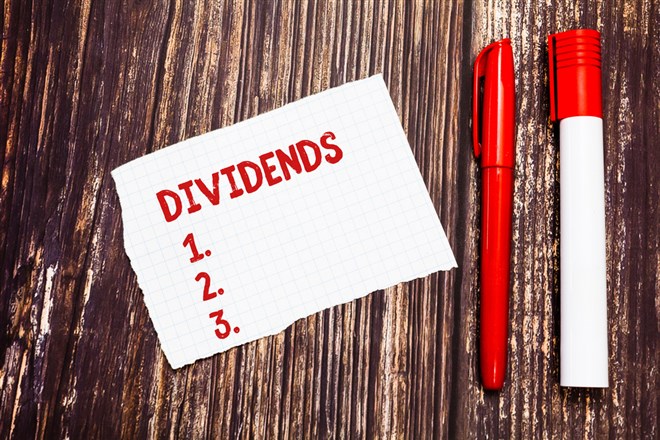
The dividend payout ratio is among the most crucial dividend metrics for new investors to master. Consider learning how to calculate dividend payout ratio to learn the dividend payment measure relative to a company's earnings. The higher the ratio, the more a company's earnings are paid as a dividend and vice versa.
Dividend Payout Ratio Formula
The dividend payout ratio formula is simple and easy to use in your search for the top dividend stocks. To find the figure, divide the company's dividend payment or distribution amount by the earnings per share. You can do this every quarter or annually, but know what you're looking at. For example, a company that earns $1 per share in EPS and pays out $0.25 in dividends has a payout ratio of 25%. If you want to know the answer to "how are dividends calculated?" or how to calculate dividends, you can check out our other articles.
The dividend payout ratio formula looks like this:
Dividend Amount Per Year / Annual Earnings per Share = Payout Ratio
In practice, the formula looks like this:
$0.25 / $1 = 0.25 or 25%
Where to Find Dividend Payout Ratio Numbers
Most stock market tracking websites usually list dividend payout ratio figures. The payout ratio goes alongside the other pertinent dividend information, but it is easy to find if not. Look at the latest earnings report and analysts' commentary to give you an idea of year-to-date earnings, guidance and the expectation for full-year earnings per share. The report should also provide information about the dividend, including the distribution amount per share.
How to calculate dividend payout? Divide the distribution amount by the earnings per share and express it as a percent. It can help you decide which stocks to own but not how many dividend stocks to own.
Retention Ratio vs. Dividend Payout Ratio
The retention ratio is the exact opposite of the payout ratio. If a company pays out 50% of its earnings in dividends and keeps 50% for corporate use, it has a retention ratio of 50% and a payout ratio of 50%. If the company only retains 25% of its earnings and pays out the other 75%, the retention ratio is 25%. When it comes to growth companies, a higher retention rate is better than a lower one, but for dividend companies, a lower retention rate is better.
Dividend Yield vs. Dividend Payout Ratio
The dividend yield formula and dividend payout ratio formula deliver two very closely related figures. The first is the rate of return that an investor can expect from an investment. The dividend yield is the dividend distribution amount divided by the stock price and represented as a percentage. This percentage is akin to the interest rate on a savings account.
On the other hand, the dividend payout ratio is a measure of dividend distributions relative to a company's earnings. A company that pays all of its earnings to investors as a dividend will have a payout ratio of 100%, while one that only pays out a quarter of earnings will have a ratio of 25%. While the dividend yield tells an investor how much investment return to expect, the payout ratio shows the safety of the distribution.
Example of Using the Dividend Payout Ratio
The dividend payout ratio is a simple and effective tool for gauging the health and attractiveness of a dividend-paying stock. Here is an example of how to use it to find the best dividend stock by sector.
Let's say an investor wants to purchase a high-quality consumer staple stock while maximizing value and yield. To make fair comparisons, they build a chart with the yield, payout ratios and P/E multiples for a group of consumer staple stocks. It might look something like this:
- The Kraft Heinz Company (NASDAQ: KHC): 3.95% yield, 58.8% payout ratio and 15x P/E multiple
- Hormel Foods Corporation (NYSE: HRL): 2.4% yield, 56% payout ratio and 24x P/E multiple
- Lamb Weston Holdings Inc. (NYSE: LW): 1.25% yield, 36% payout ratio and 35x P/E multiple
In this example, it is easy to see that Lamb Weston has the safest payout, with a payout ratio of 36% of its earnings. The drawback is that investors have to pay 35x earnings to get that safety. That is a valuation of more than double Kraft Heinz with a yield of less than half. Hormel and Kraft both have similar payout ratios, so the choice between them comes down to value and yield. Because Kraft Heinz offers value and a good dividend yield, it may be the better choice for income investors.
How Dividends Impact Financial Statements
Dividends impact financial statements in two ways. The first way is an impact on the liabilities. When the dividend is declared but not yet paid, the company records a liability called "dividends payable" to reduce cash flow and unrestricted cash balance on the balance sheet. The second is the impact to the company's earnings and cash balance. When the distribution is paid, the liability to shareholders reverses but cash transfers to their account to make up the difference.
For example, if a company records $1 billion in earnings and issues a $0.10 dividend on 500 million shares, it will have to record a liability of $50 million on its cash flow statement. It would restrict cash flow by $50 million and eventually reduce the cash balance by that amount. As long as the distribution doesn't exceed earnings on an annualized basis, the payout is relatively safe. When a company's payout shows less annualized earnings and results in a dwindling cash balance on the balance sheet, it is a problem.
How to Interpret Dividend the Payout Ratio Calculation
The dividend payout ratio can give a lot of information about a stock, its dividend and its financial health. At face value, the payout ratio tells you how much of earnings are paid as dividends, which also tells how much of earnings are available for the company's use. A higher payout ratio means the company has less of its capital available for reinvestment and may have to rely on debt to fund expansions or other operations. A lower payout ratio means the company has more free cash flow to use for its own purposes, which ultimately should be in the interest of shareholders.
The caveat with the payout ratio is that it, along with everything else in the stock market, is relative. The payout ratio is relative to the sector and industry and the company's maturity. Early-phase startups don't pay dividends because they usually don't have positive free cash flow, but more mature companies will. Mature companies don't have to invest as much in growth or may have healthier balance sheets to pay more earnings to investors. A company with a high level of debt will have fewer earnings available for dividend distributions because of the cost of the debt (the payments it has to make to repay it).
Some sectors and industries are known for paying out more or less of their earnings on a sector-to-sector basis. One sector that pays out large amounts of earnings is the utility sector. Other investments like REITs and BDCs must, by law, pay out a minimum quantity, which is 90% of taxable income in the case of REITs. When interpreting the payout ratio, always check one stock against its industry and sector peers and then make sure it carries a manageable amount of debt and can cover the payouts.
Payout Ratio: The First Sign of Dividend Health
The payout ratio is among the most critical metrics for dividend investors. It tells how much of a company's earnings are being paid as dividends which have a bearing on the dividend health and the company's ability to fund its operations. Companies with high payout ratios have less free capital in the cash flow statement and balance sheet for investment and growth.
FAQs
What is the formula for dividend payout?
The formula to calculate the dividend payout ratio formula is easy. Divide the dividend distribution amount by earnings expressed as a percentage: Dividend/Earnings = Payout Ratio.
What is a normal dividend payout ratio?
There is no "normal" payout ratio because the amount of money a company pays as a dividend is entirely up to its management. As a rule of thumb, higher payout ratios are better than lower payout ratios, but this, too, is relative. Always compare the payout ratio of one stock with other stocks in the same industry and sector.
How do you calculate dividend payout on a balance sheet?
You can calculate dividend payout relative to the balance sheet to help determine dividend health. The payout will be a subtraction from the cash balance, so if the cash balance is insufficient and the cash flow won't cover the payment, the distribution may be at risk.






